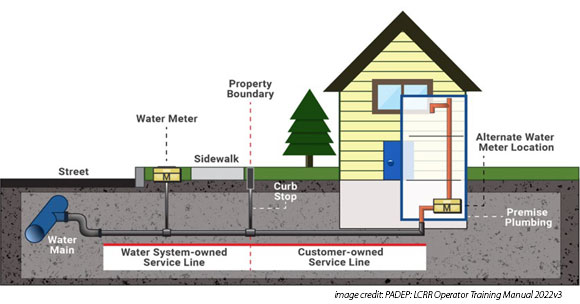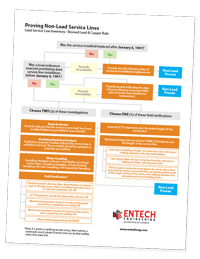Posted by Tori Morgan on Thursday, July 6, 2023
Many of us have been through training on the Revised Lead Service Line Rule, but as often happens with new and broad-reaching regulations, we are still left with many questions. We were too, so we crafted this post to help answer the frequently asked questions by water system owners.
1.What is the Lead Service Line (LSL) Inventory requirement?
Per the Revised Lead and Copper Rule | US EPA (RLCR), water systems must submit a service line inventory, identifying service lines as lead, non-lead, galvanized requiring replacement (GRR), or lead status unknown, and an associated LSL Replacement Plan by October 16, 2024.
2. Should I be working on my inventory now? How long will this take?
Since each public water system is different, there is no easy answer to the amount of time that will be required. However, it is a good idea to start now to identify information gaps and begin investigation and verification methods to best deal with each unclassified service line.
3. What is a Service Line? For what portion is the water system responsible?

Source: PADEP LCRR Service Line Inventory Operator Training
For purposes of the service line inventory, it is the entire pipe system that connects the water main to the building inlet. It may all be owned by the water system, the property owner, or both as depicted in the graphic provided by the Pennsylvania Department of Environmental Protection (PADEP).
4. What are the inventory requirements?
- Include all service lines.
- Categorize each service line with the required designations: lead, non-lead, galvanized requiring replacement (GRR), or lead status unknown.
- Identify and track each service line material(s) as they are encountered. Note: there may be more than one material, so allow multiple choices in your recording method and database.
- Use water system historical records and information to help identify the material(s) of service lines.
- Include a unique location identifier for each service line.
- Update annually.
- Make the inventory publicly accessible.
PADEP developed an inventory form that outlines the information required for service line identification and documentation – PADEP LSL Inventory Template. Use of this form is not required, but it can be a valuable tool in understanding what information must be reported. If a water system chooses to develop its own inventory system, data must be able to be exported as a CSV file and uploaded via PADEP’s Greenport system.
5. What is considered a Lead Service Line?
A service line where any portion of pipe that is made of lead, which connects the water main to the building inlet, must be identified as lead. However, there is an exception. Service lines with only a lead gooseneck, pigtail, or connector are not considered lead service lines under the RLCR.
A galvanized service line in which any portion of the pipe was downstream of any portion of a LSL, lead gooseneck, pigtail, or connector, or service line of unknown materials is considered galvanized requiring replacement (GRR).
The weight of proof is in identifying non-lead service lines. Any service whose material is unknown is assumed to be lead until proven otherwise via the methods approved by PADEP.
6. Do I need to dig up everything?

Proving Non-Lead Service Lines Flow Chart
Thank goodness, no! You can prove a service line is non-lead in many ways, with excavating as a last resort. Our Proving Non-Lead Service Lines Flow Chart outlines identification methods and required documentation of non-LSL.
Examples include:
- Installation Documentation: If documentation is available to confirm that service lines were installed/replaced after January 6, 1991, or if a local ordinance was enacted prohibiting lead service line installation before January 6, 1991, and documentation confirms installation after the enactment of the local ordinance, this constitutes sufficient evidence that a service line is non-lead.
- Modeling/Statistical Analysis: If a water system is verifying records using a field method, a statistically sound subset of service lines can be field verified rather than checking every line. PADEP recommends that systems follow the Michigan EGLE “Minimum Service Line Material Verification Requirements” to determine the statistically sound subset. PADEP will not establish modeling criteria. Instead, it is up to the water system to ensure that a statically sound model is developed and can be defended.
- Additional Acceptable Documentation for Non-Lead Service Lines:
- Construction and plumbing codes, permits, local ordinances, and existing records that require non-lead materials for water system installations and maintenance
- Meter installation records
- Historical records of installation and maintenance, such as water company tap cards
- Capital improvement or master plans
- Standard Operating Procedures
- Inspection records
- Municipal tax records, which typically contain the date of home construction
- Customer surveys such as the EPA’s Protect Your Tap – A Quick Check for Lead
7. What happens if I don’t finish my inventory? What happens if I put in all “unknowns”? What happens if I do nothing?
EPA is handling all enforcement related to the RCLR; on a federal level, failure to complete a service line inventory by the compliance date is considered a health-based violation. PADEP expects many water systems will have unknown service lines. Unknown service lines are treated like lead lines until proven otherwise, so systems must create a Lead Service Line Replacement Plan, implement risk mitigation measures after the disturbance of an unknown service line, and must provide public notification to those customers served by an unknown service line.
Categories: Municipal Infrastructure
Tagged: Potable Water | Regulations | Revised Lead & Copper Rule (RLCR)